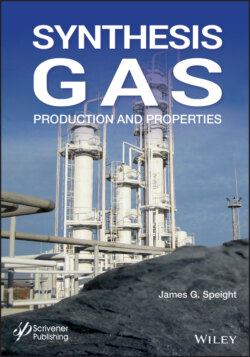Читать книгу Synthesis Gas - James Speight G., James G. Speight - Страница 18
1.3.1 Coal
ОглавлениеCoal of various types (Table 1.2) is an organic sedimentary rock that is formed from the accumulation and preservation of plant materials, usually in a swamp environment (Speight, 2013a, 2013b). Coal is a combustible rock and along with crude oil and natural gas it is one of the three most important fossil fuels, such as for the generation of electricity and provides approximately 40% of electricity production on a worldwide basis. In many countries these data are much higher: Poland relies on coal for approximately 94% of its electricity; South Africa relies on coal for approximately 92% of its electricity; China relies on coal for approximately 77% of its electricity; and Australia relies on coal for approximately 76% of its electricity.
Table 1.2 Types of coal.
| Coal type | Description |
| Lignite | Also referred to as brown coal. |
| The lowest rank of coal. | |
| Used almost exclusively as fuel for steam-electric power generation. | |
| Jet is a compact form of lignite that is sometimes polished and has been used as an ornamental stone since the Iron Age. | |
| Sub-bituminous coal | The properties range from those of lignite to those of bituminous coal. |
| Primarily as fuel for steam-electric power generation. | |
| Bituminous coal | A dense coal, usually black, sometimes dark brown, often with well-defined bands of brittle and dull material, |
| Used primarily as fuel in steam-electric power generation. | |
| Also used for heat and power applications in manufacturing and to produce coke. | |
| Anthracite | The highest rank coal. |
| A hard, glossy, black coal. | |
| Used primarily for residential and commercial space heating. |
Total recoverable reserves of coal around the world are estimated at 891,531 million tons – the United States has sufficient coal reserves to last (at current rates of consumption) in excess of 250 years (BP, 2019). Even though coal deposits are distributed widely throughout the world, deposits in three countries account for approximately 57% of the world recoverable coal reserves, viz., United States (27%), Russian Federation (18%), and China (13%), and another six countries account for 30% of the total reserves: Australia (9%), India (7%), Ukraine (4%), Kazakhstan (4%), South Africa (3%), and Japan (3%). Coal is also very unequally and unevenly distributed in the world, just as other fossil fuels such as crude oil and natural gas.
Coal has been studied extensively for conversion into gaseous and liquid fuels as well as hydrocarbon feedstocks. Largely thanks to its relative abundance and stable fuel price on the market, coal has been a focal target for synthetic conversion into other forms of fuels, i.e., synfuels. Research and development work on coal conversion has seen peaks (highs) and valleys (lows) due to external factors including the comparative fossil fuel market as well as the international energy outlook of the era. Coal can be gasified, liquefied, pyrolyzed, and co-processed with other fuels including oil, biomass, scrap tires, and municipal solid wastes (Speight, 2008, 2011b, 2011c, 2013a, 2014b). Secondary conversion of coal-derived gas and liquids can generate a wide array of petrochemical products as well as alternative fuels.
For the past two centuries, coal played this important role – providing coal gas for lighting and heating and then electricity generation with the accompanying importance of coal as an essential fuel for steel and cement production, as well as a variety of other industrial activities. On a worldwide basis, in excess of 4 billion tons (4.0 x 109 tons) of coal is consumed by a variety of sectors – including power generation (steam coal and/or lignite), iron and steel production (coking coal), cement manufacturing, and as a solid fuel or a source of liquid fuels (Speight, 2013a, 2103b). In fact, coal remains an important source of energy in many countries, and is used to provide approximately 40% of electricity worldwide, but this does not give the true picture of the use of coal for electricity production. During recent times the coal industry has been pressured into consideration of the environmental aspects of coal use and has responded with a variety of on-stream coal-cleaning and gas-cleaning technologies (Speight 2013a).
Coal is the largest single source of fuel for the generation of electricity worldwide, as well as the largest source of carbon dioxide emissions, which have been implicated as the primary cause of global climate change, although the debate still rages as to the actual cause (or causes) of climate change. Coal is found as successive layers, or seams, sandwiched between strata of sandstone and shale and extracted from the ground by coal mining – either underground coal seams (underground mining) or by open-pit mining (surface mining).
Coal remains in adequate supply and at current rates of recovery and consumption, the world global coal reserves have been variously estimated to have a reserves/production ratio of at least 155 years. However, as with all estimates of resource longevity, coal longevity is subject to the assumed rate of consumption remaining at the current rate of consumption and, moreover, to technological developments that dictate the rate at which the coal can be mined. But most importantly, coal is a fossil fuel and an unclean energy source that will only add to global warming. In fact, the next time electricity is advertised as a clean energy source, just consider the means by which the majority of electricity is produced – almost
